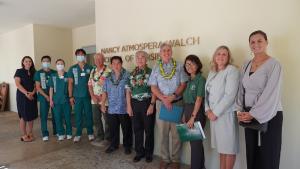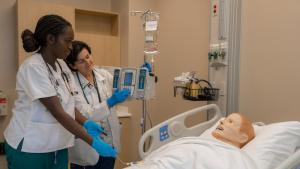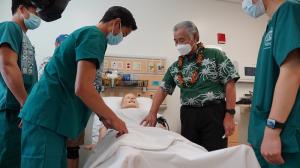$1.75M to address statewide nursing faculty shortage
University of Hawaiʻi
Gov. Ige is joined by UH President David Lassner, UH nursing leaders and students and healthcare representatives
Link to b-roll from UH Mānoa Nursing: https://bit.ly/2Z60RYk
Gov. David Ige has released $1.75 million for 39 new instructor positions to help address Hawaiʻi’s severe nursing faculty shortage and to support University of Hawaiʻi nursing programs statewide. The initiative, which Ige included in his budget request to the state Legislature that lawmakers approved during the 2022 legislative session, will help UH graduate more nurses to meet the workforce demands of the state.
A news conference was held on the UH Mānoa campus today, Thursday, October 13, to discuss the appropriation and its importance. Ige attended along with UH President David Lassner, Hawaiʻi State Center for Nursing (HSCN) Director Laura Reichhardt, UH Mānoa Nancy Atmospera-Walch School of Nursing Interim Dean Clementina Ceria-Ulep, state lawmakers and healthcare system leaders who have been supportive of the funding.
There are an estimated 1,000 current nurse vacancies in Hawaiʻi, according to the Department of Labor and Industrial Relations. Hawaiʻi State labor data predicts there is an anticipated growth of nurse demand of an additional 110 positions each year, through 2030.
“COVID-19 created an opportunity to collaborate with UH President David Lassner and the UH System to ensure our state higher education system is well positioned to help the state respond to this incredible healthcare challenge,” said Ige. “The $1.75 million I allocated for UH is an investment which will support the stability and future of nursing education in Hawaiʻi.”
The 39 positions will support instruction needs for approximately 230 nursing students. Currently, there are about 770 nursing students enrolled across the UH System: UH Mānoa, UH Hilo, UH Maui College, Kapiʻolani Community College, Kauaʻi CC and Hawaiʻi CC.
Support for state’s largest educator of nurses
UH System schools educated and trained 59% of the 442 LPN and RN students who graduated from schools throughout Hawaiʻi in the last academic year. UH nursing programs make up six of the eight pre-license nursing education programs in Hawaiʻi that prepare students for entry into LPN or RN practice. In addition, UH programs are the only way for neighbor island students to become nurses in Hawaiʻi.
UH nursing schools with the greatest faculty and instructor needs are receiving the most support, which will benefit neighbor island and community college programs.
Funding/position breakdown:
UH Mānoa—$354,767 (8 positions)
UH Hilo—$532,150 (12 positions)
UH Community Colleges—$842,572 (19 positions)
- Kapiʻolani CC—(9 positons)
- UH Maui College—(3 positions)
- Kaua‘i CC—(3 positions)
- Hawaiʻi CC—(4 positions)
Professional development training: $27,000
In order to retain the new nursing instructors, $27,000 will support their professional development to gain new competencies in nursing education.
“The funding will support the incredible contributions UH nursing schools provide to the state. I’d like to thank Gov. Ige, with the support of our state lawmakers, for investing in our academic workforce in order to improve retention of our highly talented faculty and to enroll qualified students whose dreams are to become a nurse,” said Lassner.
Meeting current, future workforce demands
Prior to the COVID-19 pandemic, state nursing schools were able to graduate an adequate number of nurses to meet workforce needs, according to the Hawaiʻi State Center for Nursing. However, in the last two academic years, there has been a loss of 15% of state-funded nursing positions. In addition, budget constraints prevented schools from receiving funds to hire replacements for faculty who left their positions.
“To regain balance, Hawaiʻi must immediately increase the number of nurses we graduate. It takes 4 years to graduate as a bachelors-prepared nurse. Efforts today will impact our nursing workforce in 4 years. The time to act is now,” said Reichhardt, who leads HSCN efforts to respond to nursing workforce shortages.
Expanding on current initiatives
The UH system continues to collaborate and work closely with HCSN and Hawaiʻi’s healthcare employers to develop strategies to ensure nursing workforce issues are addressed statewide. Ongoing and recently introduced UH initiatives that will help to meet the demands for more nurses and nurse educators in the state include:
- The UH Statewide Nursing Consortium provides UH community college nursing students the opportunity to seamlessly articulate into the baccalaureate program at UH Mānoa’s Nancy Atmospera-Walch School of Nursing (NAWSON). Students from Kapiʻolani CC, UH Maui College and Kauaʻi CC complete a common curriculum to earn an associate degree in nursing, then transition to UH Mānoa to earn a bachelor of science in nursing (BSN) from NAWSON in an additional year.
- The redesigned master’s program in nursing education and leadership offered by NAWSON provides expert clinical nurses with the skills to teach students in an academic setting. The first cohort begins in August 2023.
- A new 15-credit graduate certificate in nursing education program offered by NAWSON provides nurses with an opportunity to obtain national nursing certification as a nurse educator, most commonly employed at hospitals to teach clinical nurses. Classes begin in August 2023.
- Launched this fall is a new bachelor’s nursing pathway for UH West Oʻahu students, a unique partnership between UH West Oʻahu and UH Mānoa. Upon completion of pre-nursing prerequisites at UH West Oʻahu, students transfer their credits to enroll in the NAWSON program to earn their BSN. Students will take courses at UH West Oʻahu to reduce travel and receive instruction closer to their home communities.
“I'd like to acknowledge the unified effort between the nursing schools and nursing employers for their commitment to local nursing education, hiring new graduates into the workforce, and ensuring coordinated and close communication that helps us plan for the future,” said Reichhardt.
UH is actively recruiting and hiring for the nursing lecture positions. For more information, visit Work at UH.


